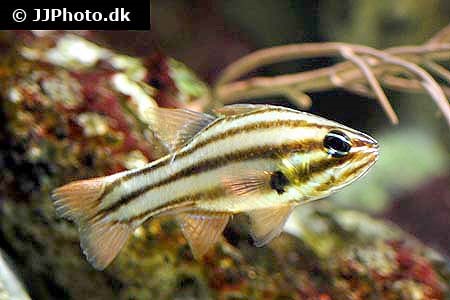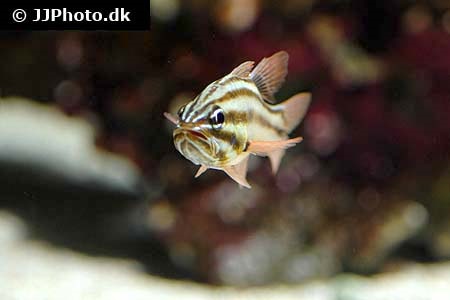Ostorhinchus novemfasciatus


| Latin name | Ostorhinchus novemfasciatus - (Cuvier, 1828) |
|---|---|
| Local name | Sevenstriped cardinalfish |
| Family | Apogonidae - Ostorhinchus |
| Origin | Australia, Japan, Indonesia, Central/West Pacific |
| Max length | 10 cm (3.9") |
| Minimum volume |
150 l (40 gal) |
|---|---|
| Hardiness |
Average |
| Suitable for aquarium |
Suitable for most aquarium |
| Reef safe |
Always reef safe |
| Aggressiveness | Mostly peaceful but might be aggressive towards similar species |
| Recommended |
Small crustaceans (Krill, mysis, artemia...) Zooplankton (Cyclops, pods...) |
|---|---|
| Maybee |
Fish Larger crustaceans (Shrimp, crabs...) |
This spicies might be a threat to smaller fishes.
This species can be a threat towards small crustaceans, e.g. small shrimp.
This species needs good hiding places, for example, between live rocks.
This species is nocturnal and therefore the most active when the light is dimmed or turned off.
Species are sometimes reclassified. This species was formerly classified as a member of the Apogon genus.
This fish can be aggressive towards members of its own kind, but when provided with enough space it will thrive better in a small group.
Cardinalfish come in many different shapes and colours, generally they are well suited for aquaria.
Cardinalfish have a large mouth and a big appetite, take this into account with feeding the other fish. These fish typically live off of Artemia, Mysis and krill. In the aquarium they will eat anything they can.
They will sometimes eat small shrimps and fish, so do be aware of this, but it is not normally a problem.
It is possible to keep several species together, if space allows. Some species will form small shoals. They are normally peaceful towards other fish, but will sometimes fight among themselves if there isn't sufficient space or food.
Many species are nocturnal and will therefore often seek a hiding place during the day. This can be between stones, SPS corals and, in some cases, in an anemone and between spines of Sea urchins.
Cardinalfish are a good choice if ones wishes to attempt to start a breeding tank.
| Distribution | Pacific Ocean: Christmas Island in the eastern Indian Ocean to the Line Islands, north to the Izu Islands, south to Great Barrier Reef. |
|---|---|
| English common names |
Seven-striped cardinalfish Nine-banded soldierfish Nine-line cardinalfish Nineline cardinalfish |
| Danish common names |
Nistribet kardinalfisk |
Scott W. Michael. 2001. Basslets, Dottybacks & Hawkfishes: v. 2 (Reef Fishes) - TFH Publications / Microcosm Ltd. - (English)
Bob Fenner. Cardinalfishes, Family Apogonidae, Pt. 1, Pt. 2 - Wet Web Media - (English)

